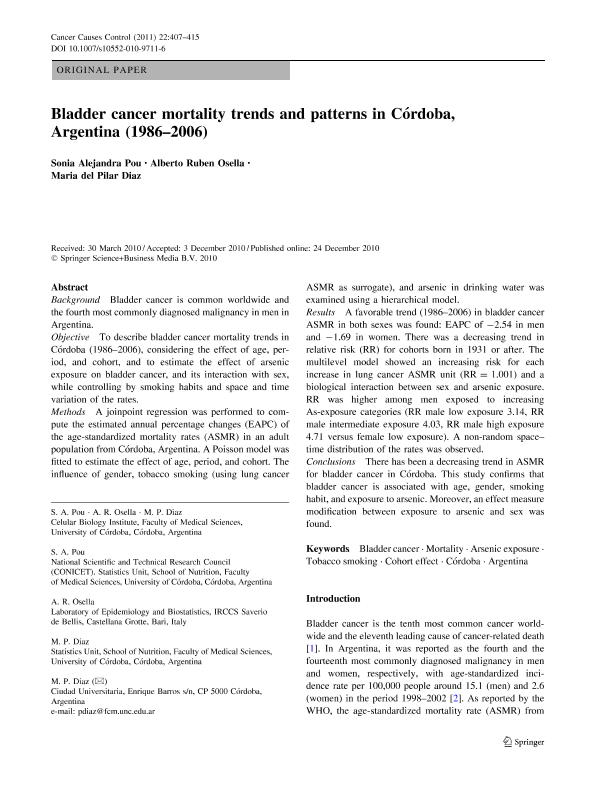Mostrar el registro sencillo del ítem
dc.contributor.author
Pou, Sonia Alejandra

dc.contributor.author
Osella, Alberto Ruben
dc.contributor.author
Diaz, Maria del Pilar

dc.date.available
2023-03-13T11:28:28Z
dc.date.issued
2011-03
dc.identifier.citation
Pou, Sonia Alejandra; Osella, Alberto Ruben; Diaz, Maria del Pilar; Bladder cancer mortality trends and patterns in Córdoba, Argentina (1986-2006); Springer; Cancer Causes & Control; 22; 3; 3-2011; 407-415
dc.identifier.issn
0957-5243
dc.identifier.uri
http://hdl.handle.net/11336/190282
dc.description.abstract
Background Bladder cancer is common worldwide and the fourth most commonly diagnosed malignancy in men in Argentina. Objective To describe bladder cancer mortality trends in Córdoba (1986-2006), considering the effect of age, period, and cohort, and to estimate the effect of arsenic exposure on bladder cancer, and its interaction with sex, while controlling by smoking habits and space and time variation of the rates. Methods A joinpoint regression was performed to compute the estimated annual percentage changes (EAPC) of the age-standardized mortality rates (ASMR) in an adult population from Córdoba, Argentina. A Poisson model was fitted to estimate the effect of age, period, and cohort. The influence of gender, tobacco smoking (using lung cancer ASMR as surrogate), and arsenic in drinking water was examined using a hierarchical model. Results A favorable trend (1986-2006) in bladder cancer ASMR in both sexes was found: EAPC of -2.54 in men and -1.69 in women. There was a decreasing trend in relative risk (RR) for cohorts born in 1931 or after. The multilevel model showed an increasing risk for each increase in lung cancer ASMR unit (RR = 1.001) and a biological interaction between sex and arsenic exposure. RR was higher among men exposed to increasing As-exposure categories (RR male low exposure 3.14, RR male intermediate exposure 4.03, RR male high exposure 4.71 versus female low exposure). A non-random space- time distribution of the rates was observed. Conclusions There has been a decreasing trend in ASMR for bladder cancer in Córdoba. This study confirms that bladder cancer is associated with age, gender, smoking habit, and exposure to arsenic. Moreover, an effect measure modification between exposure to arsenic and sex was found.
dc.format
application/pdf
dc.language.iso
eng
dc.publisher
Springer

dc.rights
info:eu-repo/semantics/openAccess
dc.rights.uri
https://creativecommons.org/licenses/by-nc-sa/2.5/ar/
dc.subject
ARGENTINA
dc.subject
ARSENIC EXPOSURE
dc.subject
BLADDER CANCER
dc.subject
CÓRDOBA
dc.subject
COHORT EFFECT
dc.subject
MORTALITY
dc.subject
TOBACCO SMOKING
dc.subject.classification
Epidemiología

dc.subject.classification
Ciencias de la Salud

dc.subject.classification
CIENCIAS MÉDICAS Y DE LA SALUD

dc.title
Bladder cancer mortality trends and patterns in Córdoba, Argentina (1986-2006)
dc.type
info:eu-repo/semantics/article
dc.type
info:ar-repo/semantics/artículo
dc.type
info:eu-repo/semantics/publishedVersion
dc.date.updated
2023-03-10T14:29:35Z
dc.journal.volume
22
dc.journal.number
3
dc.journal.pagination
407-415
dc.journal.pais
Alemania

dc.description.fil
Fil: Pou, Sonia Alejandra. Universidad Nacional de Córdoba. Facultad de Medicina. Escuela de Nutrición. Cátedra de Estadística y Bioestadística; Argentina. Consejo Nacional de Investigaciones Científicas y Técnicas. Centro Científico Tecnológico Conicet - Córdoba; Argentina
dc.description.fil
Fil: Osella, Alberto Ruben. Universidad Nacional de Córdoba; Argentina
dc.description.fil
Fil: Diaz, Maria del Pilar. Universidad Nacional de Córdoba; Argentina
dc.journal.title
Cancer Causes & Control

dc.relation.alternativeid
info:eu-repo/semantics/altIdentifier/url/https://link.springer.com/article/10.1007/s10552-010-9711-6
dc.relation.alternativeid
info:eu-repo/semantics/altIdentifier/doi/http://dx.doi.org/10.1007/s10552-010-9711-6
Archivos asociados
